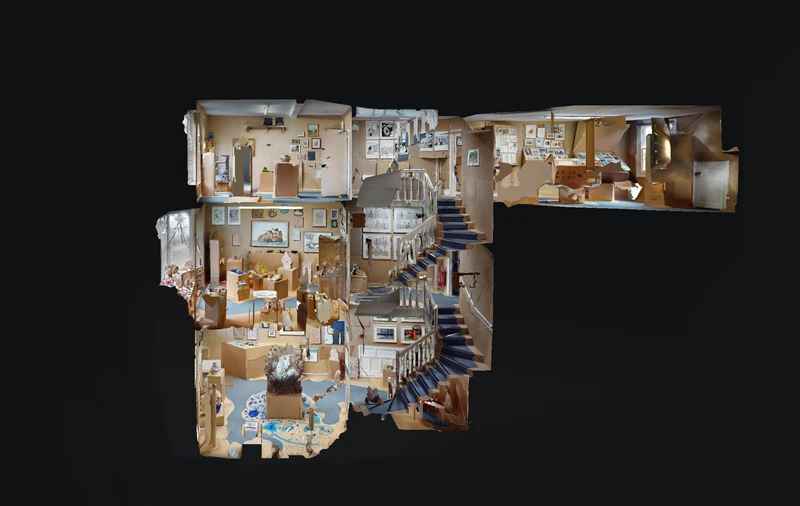Andy Holden's Collected Domestic Conceptualism
17 Jul-9 Oct 2021


Guide to the house:
Room 1(Living Room): Accretions, Aphorisms, Bower, Chewy Cosmos, Evolution, Manifestos, Mediated Emotions, Nests, Ornamites, Sentimental Pictures.
Room 2 (Study): Allusions, Archeology, Cats, Coach trips, Decorative Bowls, Eyes, Fragments, Hermeneutics, Make-up, Ornithology, Pyramids, Reclining Figures, Souvenirs, Topoanalysis, Postcards, Wardrobes.
Room 3 (Guest Room): Artist As Critic as Cartoon
Room 4 (Window Room): Folly, Landscapes, Models, Over-paintings, Proposals for Public Sculptures, Relics, Unfeeling.
Room 5 (Library): Works on paper, (From the Particular to the Universal)
Collected Domestic Conceptualism places together for the first time various small works, studies, models, paintings and drawings by Andy Holden, set in a temporary cardboard museum, assembled across a three-storey town house in the centre of Worcester. Experienced together the feeling is somewhere between the opening up of Holden’s storage, with the works displayed on cardboard packing boxes, and due to the decontextualised floor-to-ceiling hang, an idiosyncratic reworking of the Soane Museum interior. Holden’s has become known for a number of dense bodies of work which often present their own fully realised theory or propositions: Thingly Time (2011), Maximum Irony! Maximum Sincerity (2003/2013), and that the world should be understood as a cartoon (Laws of Motion in a Cartoon Landscape, 2016). More recent exhibitions have provided performative re-workings of existing theories through a collision of media, such as Natural Selection (2017) or Structure of Feeling (2020).
In Collected Domestic Conceptualism we see the attempt to group small pieces which are related to these larger projects with numerous unseen and orphaned works from uncompleted projects, or small works unrelated to any specific exhibition, under the neologistical umbrella term ‘Domestic Conceptualism’. This term is used to point both to a scale of the work, as well as an ambition for how the work should be understood, and as a way of making connection between these pre- existing and previously delineated bodies of work.
‘Conceptualism’ here is used to invoke the idea of the attempt to describe the universal through particular instances, with ‘domestic’ alluding to the nature of the materials that are used throughout, as well as many of the themes found in the various bodies of work. Nests, make-up, painted bowls, cartoon’s from childhood, ceramic cats, eggs, wallpaper, friendship, aphorisms, souvenir’s, googly eyes, reworked charity-shop paintings, knitted objects, stickers, Bitmoji imagery, postcards, and solidified accretions of builders plaster and household paint all in different ways set up a dialectical motion between house and universe.
As with his previous exhibitions the attempt to build a framework around how the work should be understood becomes part of the work itself. Here many of the works are freed from their previous dyadic narrative frameworks to be looked at afresh as part of a longer, ongoing, and broader practice.
The exhibition has been assembled to primarily be visited remotely and to construct a digital archive. The five rooms and adjoining corridors will all be 3D scanned in detail and available to view online; the exhibition conceived so that the digital render should be the primary means of experiencing the collection of works. The house will be open on Friday and Saturdays and by appointment, but many of the rooms can only be viewed through the doorways to each room.
The exhibition was conceived to coincide with the publishing of Collected Free Labour - Blog Interviews 2010-2020, published by Slimvolume. The book, which includes an essay by Andrew Hunt, The Critic as Artist as Cartoon, brings together ten years of online interviews by Holden, collaged together to make one long, non-linear conversation in which Holden attempts to describe the intentions and motivations for his work as a whole. These re-claimed interviews are intercut with a new conversation with Tyler Woolcott in which he asks Holden to reflect on previously given answers and opens the conversation up onto the responsibility of an artist to control the meaning of their own work, and in the process frames these collected interviews as part of the work as a whole. An animated version of Holden narrates the first part of the book in room 3 of the exhibition.
Andy Holden's Collected Domestic Conceptualism | PRESS RELEASE
Download